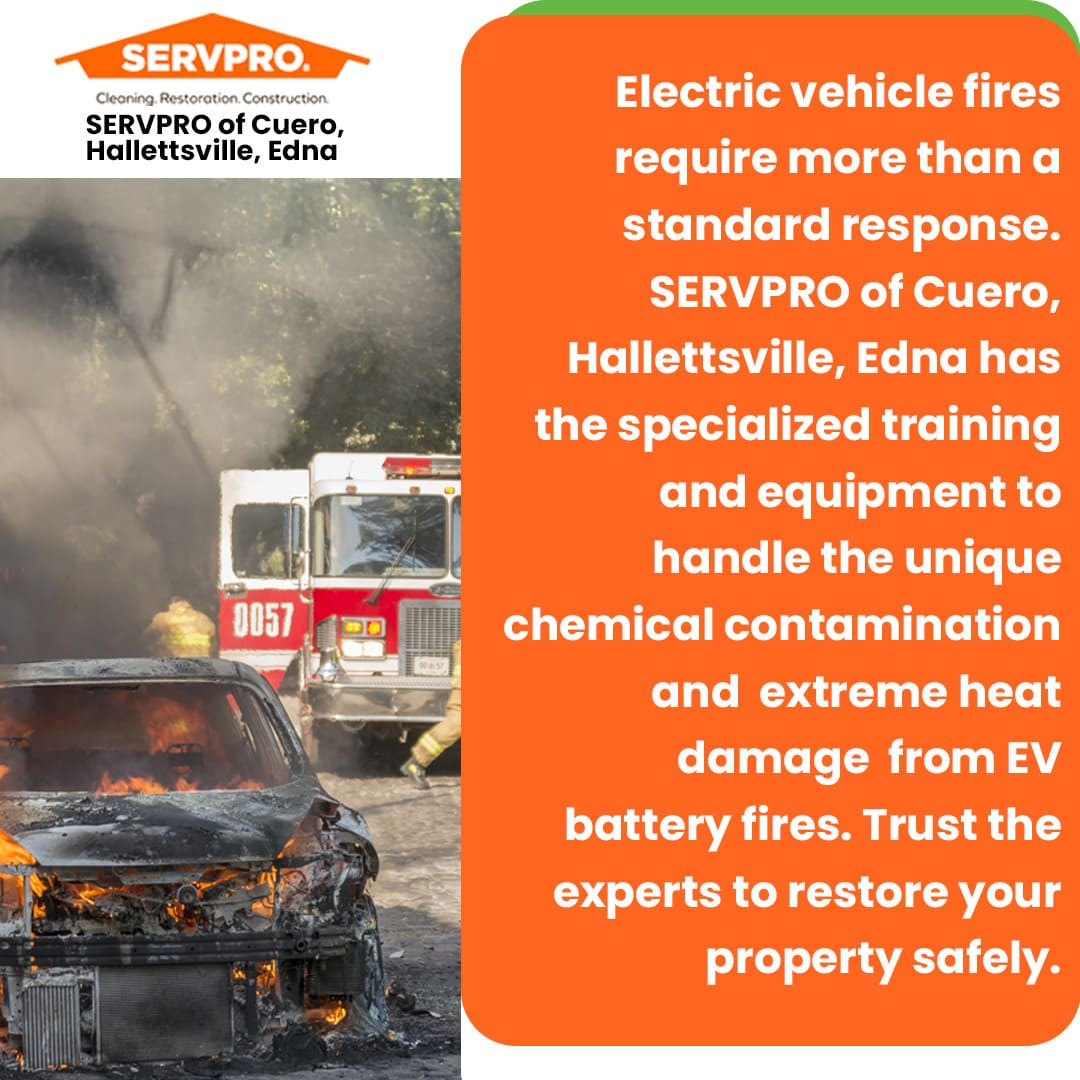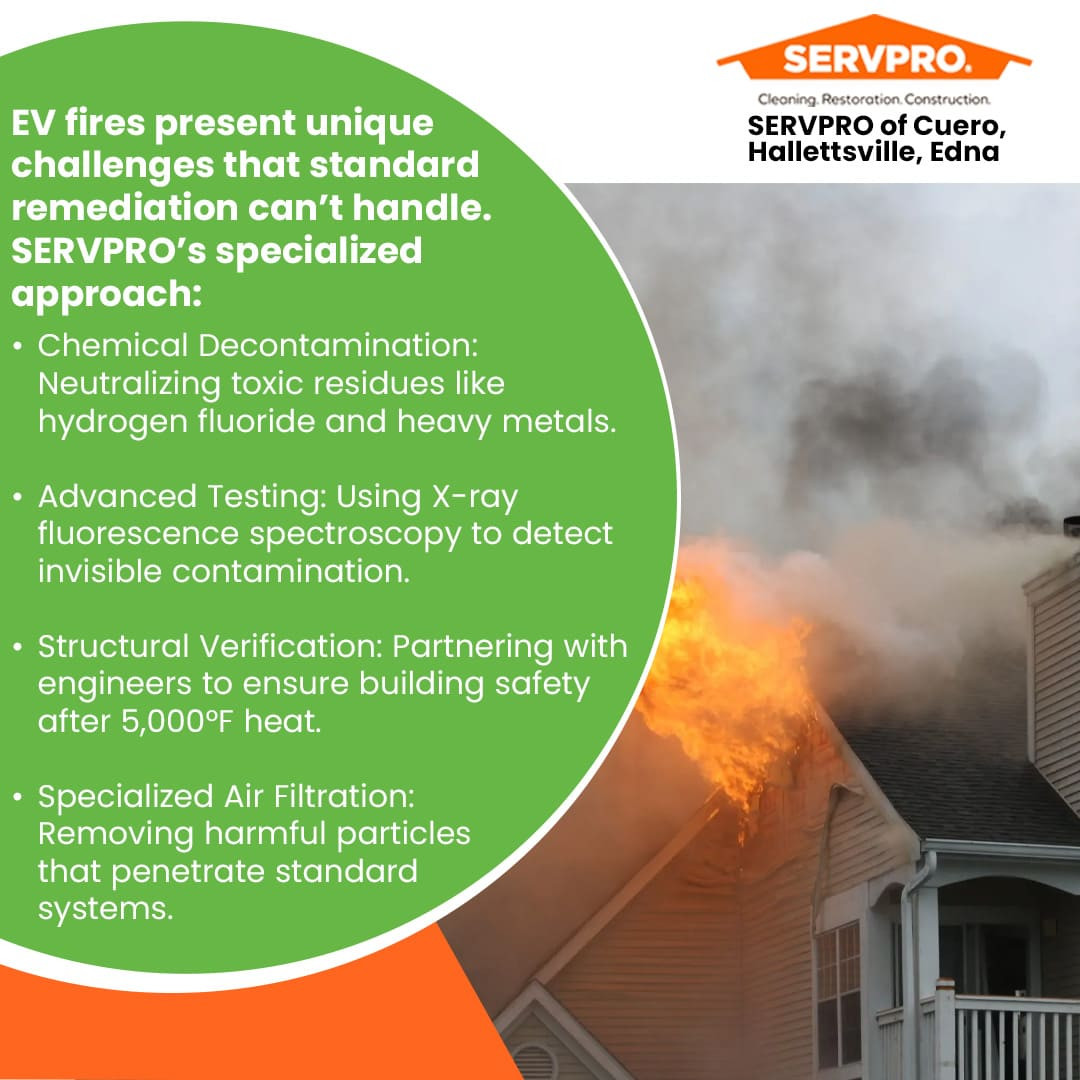How electric vehicle garage fires require specialized fire damage remediation techniques
San Antonio, United States - November 14, 2025 / SERVPRO of Cuero, Hallettsville, Edna /
San Antonio, Texas – The rapid adoption of electric vehicles across Texas has created unexpected challenges for property restoration companies, with lithium-ion battery fires presenting complexities that traditional fire damage remediation methods cannot adequately address. SERVPRO of Cuero, Hallettsville, Edna reports a significant increase in EV-related fire incidents requiring specialized equipment, training, and safety protocols that exceed conventional restoration approaches.

Chemical contamination redefines industry standards
Toxic residues demand specialized treatment protocols
Electric vehicle fires produce chemical compounds fundamentally different from traditional combustion events. Battery fires release hydrogen fluoride, phosphorus pentafluoride, and heavy metal particles that penetrate building materials at the molecular level. These substances resist standard smoke removal techniques, requiring restoration professionals to employ specialized neutralizing agents and advanced filtration systems designed specifically for chemical contamination.
The extreme temperatures generated during thermal runaway events—exceeding 5,000 degrees Fahrenheit—create damage patterns that restoration professionals haven't encountered with conventional vehicle fires. Materials typically salvageable after standard fires often require complete replacement due to chemical contamination and thermal degradation.
Health hazards extend beyond the initial incident
Fire damage repair for EV incidents involves managing persistent health risks that continue long after flame suppression. Heavy metals, including cobalt, nickel, and manganese, deposit throughout properties, creating exposure risks that standard cleaning methods cannot eliminate. SERVPRO of Cuero, Hallettsville, Edna employs sophisticated testing equipment, including X-ray fluorescence spectroscopy, to detect invisible contamination that poses long-term health threats.
The company's technicians undergo specialized training to handle these hazardous materials safely, utilizing enhanced personal protective equipment and following protocols developed specifically for battery fire contamination. Air quality monitoring continues for weeks following initial remediation, as off-gassing from contaminated materials can persist long after visible cleanup completion.
Insurance industry struggles with coverage interpretations
Documentation requirements evolve with technology
Insurance adjusters face unprecedented challenges evaluating EV fire claims, as traditional policies weren't written to address lithium battery incidents. The specialized fire damage remediation these events require often costs 50-200% more than conventional fire restoration, creating coverage disputes between property owners and insurance providers.
Professional restoration companies now provide comprehensive documentation packages including thermal imaging data, chemical contamination test results, and detailed explanations of why battery fires require different treatment approaches. This educational component helps adjusters understand cost variations and approve appropriate coverage for necessary restoration work.
Structural assessments reveal hidden damage
The intense, sustained heat from EV fires compromises structural integrity beyond what standard assessment procedures evaluate. Steel beams lose load-bearing capacity, concrete develops micro-fractures, and fasteners fail from extreme thermal cycling. Professional restoration companies coordinate with structural engineers to verify building safety before beginning cosmetic repairs.
Regional factors amplify Texas fire risks
Climate conditions affect battery performance
Texas's extreme temperatures and humidity levels create conditions that stress EV batteries beyond manufacturer specifications. High ambient temperatures combined with charging heat can trigger thermal management system failures. Properties throughout the San Antonio region face increased risks during the summer when temperatures regularly exceed 100 degrees Fahrenheit.
SERVPRO of Cuero, Hallettsville, Edna has observed seasonal patterns in battery-related incidents, with peak occurrences during extreme weather events. The company maintains emergency response capabilities specifically for these high-risk periods.
Local infrastructure adapts to new challenges
Fire departments across Texas are developing specialized suppression techniques for lithium battery fires, which require up to 40,000 gallons of water compared to 500 gallons for conventional vehicle fires. This massive water volume creates secondary damage requiring extensive water extraction and decontamination. The contaminated water becomes classified as hazardous waste, requiring special handling and disposal procedures that complicate fire damage repair processes.
Rural communities particularly struggle with resource limitations for handling EV fires. Limited access to specialized equipment and training means initial suppression efforts might be less effective, resulting in more extensive damage requiring professional smoke removal and restoration services.
Technology evolution drives industry adaptation
Advanced equipment addresses modern challenges
Restoration companies invest heavily in technology designed specifically for chemical fire remediation. Multi-stage filtration systems combining HEPA filters with activated carbon and chemical-specific media remove compounds that traditional equipment cannot capture. These systems operate continuously for extended periods exceeding typical smoke removal project durations.
Specialized cleaning agents developed for battery residue neutralization prevent dangerous chemical reactions while effectively removing contamination. These products require careful application by trained professionals who understand chemical compatibility and reaction risks.
Prevention strategies emerge from experience
Following fire damage remediation, property owners increasingly implement preventive measures, including fire-resistant garage modifications, dedicated charging circuits with appropriate amperage ratings, and early detection systems monitoring battery thermal events. Professional restoration companies provide consultation services, helping property owners understand and mitigate EV fire risks.
SERVPRO of Cuero, Hallettsville, Edna assists clients with post-restoration safety upgrades, connecting them with qualified contractors who understand EV infrastructure requirements and fire prevention strategies specific to battery technology.

About SERVPRO of Cuero, Hallettsville, Edna
SERVPRO of Cuero, Hallettsville, Edna specializes in advanced fire damage remediation services, including specialized protocols for electric vehicle battery fires. The company's certified technicians combine cutting-edge technology with comprehensive training to address chemical contamination, extreme heat damage, and persistent health hazards unique to modern fire incidents. Their expertise spans from initial emergency response through complete restoration, with direct insurance coordination to streamline claims processing for complex EV fire damage cases.
For professional fire damage restoration services, contact SERVPRO of Cuero, Hallettsville, Edna at (361) 248-2388 or email office+4@servpro11423.com. Emergency response available 24/7.

Contact Information:
SERVPRO of Cuero, Hallettsville, Edna
2730 S Foster Rd
San Antonio, TX 78220
United States
Billy Maggard
(361) 248-2388
https://www.servpro.com/locations/tx/servpro-of-cuero-hallettsville-edna

